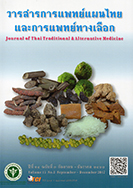Physico-chemical specification of Bael fruit
Main Article Content
Abstract
Study on physico-chemical characteristics of Bael fruits [Aegle marmelos (L.) Corrêa] family Rutaceae aimed to obtain specification data to establish standard for chemical quality control for this kind of medicinal plant. From 29 samples of Bael fruits were collected from natural sources and traditional drugstores during June 2011 – April 2013. Chemical identifications using color reaction and thin layer chromatography and evaluation of physico-chemical properties including contents of water, total ash, acid-insoluble ash, 95%ethanol extractive, 50%ethanol extractive and water extractive were performed. The percentage of these values were calculated. Study on color reaction of ethanolic extract of Bael fruits exhibited positive result with Liebermann Burchard, Shinoda’s and 1% FeCl3. It also showed to clear the color of KMnO4 solution . In chemical identification by TLC technique, silica gel GF254 was used as stationary phase and mixture of toluene and ether (3 : 2) was used as mobile phase. Spot of imperatorin could be observed at Rf value of 0.67. Contents of water, total ash, acid-insoluble ash, 95%ethanol extractive, 50%ethanol extractive and water extractive were (mean±sd) 8.05±1.44, 3.15±031, 0.15±0.11, 15.78±3.71, 41.36±6.58 and 49.93±5.71% w/w, respectively. Standard for chemical quality control of Bael fruits should be established. Content of water content, total ash and acid-insoluble ash content should be not more than 9, 3 and 1% w/w, respectively. 95%ethanol, 50%ethanol and water extractive values should be not less than 14, 37 and 45% w/w, respectively. In chemical identification by TLC technique, imperatorin could be observed.
Article Details
References
2. Boonyapapat N, Chokechaicharoenporn O, editors. Samunpai Maipuenban (3). Bangkok: Prachachon Co. Ltd; 1999. 823 p. (in Thai)
3. Wutthamwet W. Encyclopedia of medicinal plants. Bangkok: O.S. Printing House; 1997. 618 p. (in Thai)
4. Dhankhar S, Ruhil S, Balhara M, Dhankhar S, Chhillar AK. Aegle marmelos (Linn.) Correa: a potential source of phytomedicine. Journal of Medicinal Plants Research. 2011;5(9): 1497-507.
5. Laphookhieo S, Phungpanya C, Tantapakul C, Techa S, Tha-in S, Narmdorkmai W. Chemical constituents from Aegle marmelos. Journal of the Brazilian Chemical Society. 2011;22(1):176-8.
6. Pattamadilok D, Sakpetch A, Thiemthieprat P, Thana-ariyaroj, Ontong S. Medicinal Plant Research Institute Final report: Physico-chemical specification of Bael fruits. Nonthaburi: Medicinal Plant Research Institute, Department of Medical Science; 2013. (28 p). (in Thai)
7. World Health Organization. Quality Control Method for Herbal Materials. Geneva: WHO Press; 2011. 173 p.


